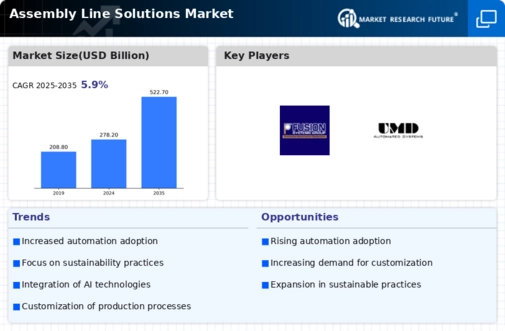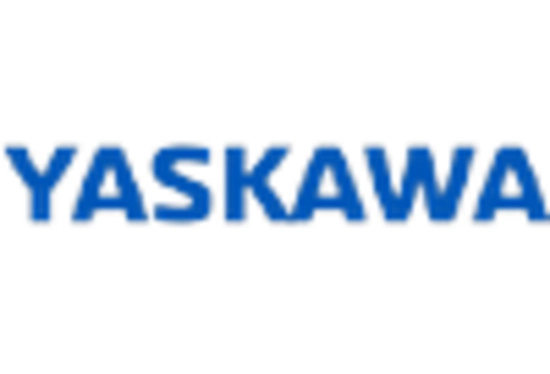The Assembly Line Solutions Market is currently characterized by a dynamic competitive landscape, driven by technological advancements and the increasing demand for automation across various industries. Key players such as Siemens (Germany), Rockwell Automation (United States), and ABB (Switzerland) are at the forefront, each adopting distinct strategies to enhance their market positioning. Siemens (Germany) emphasizes innovation through its digital twin technology, which allows for real-time simulation and optimization of production processes. Meanwhile, Rockwell Automation (United States) focuses on integrating AI and machine learning into its solutions, thereby enhancing operational efficiency and predictive maintenance capabilities. ABB (Switzerland) is pursuing a strategy of regional expansion, particularly in emerging markets, to capitalize on the growing demand for automation solutions. Collectively, these strategies contribute to a competitive environment that is increasingly centered around technological innovation and operational efficiency.
In terms of business tactics, companies are increasingly localizing manufacturing to reduce lead times and enhance supply chain resilience. This trend is particularly evident in the Assembly Line Solutions Market, which appears to be moderately fragmented, with several key players exerting significant influence. The collective actions of these companies suggest a shift towards more agile and responsive manufacturing processes, which are essential in meeting the evolving demands of global supply chains.
In August 2025, Siemens (Germany) announced the launch of its new cloud-based platform designed to enhance collaboration across the supply chain. This strategic move is significant as it aims to streamline operations and improve data sharing among stakeholders, thereby fostering greater efficiency in assembly line processes. The introduction of this platform reflects Siemens' commitment to digital transformation and positions the company as a leader in the integration of advanced technologies into manufacturing.
In September 2025, Rockwell Automation (United States) unveiled its latest AI-driven analytics tool, which is designed to optimize production schedules and reduce downtime. This development is crucial as it underscores Rockwell's focus on leveraging artificial intelligence to enhance operational performance. By providing manufacturers with actionable insights, this tool is likely to improve productivity and reduce operational costs, thereby reinforcing Rockwell's competitive edge in the market.
In July 2025, ABB (Switzerland) entered into a strategic partnership with a leading automotive manufacturer to develop customized automation solutions for electric vehicle production. This collaboration is particularly noteworthy as it aligns with the growing trend towards sustainability and the electrification of transportation. By partnering with a key player in the automotive sector, ABB is not only expanding its market reach but also positioning itself as a pivotal contributor to the future of sustainable manufacturing.
As of October 2025, the Assembly Line Solutions Market is witnessing a pronounced shift towards digitalization, sustainability, and the integration of artificial intelligence. These trends are reshaping the competitive landscape, with strategic alliances becoming increasingly important in driving innovation and enhancing operational capabilities. The focus appears to be shifting from traditional price-based competition to a more nuanced approach that prioritizes technological advancement, supply chain reliability, and sustainable practices. Looking ahead, it is likely that companies will continue to differentiate themselves through innovative solutions and strategic partnerships, thereby redefining the parameters of competition in this evolving market.

















Leave a Comment